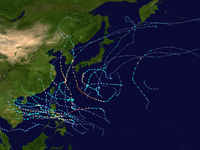
Photo from wikipedia
Seasonal rainfall in the Caribbean Basin is known to be modulated by sea surface temperature anomalies (SSTAs) in the Atlantic and Pacific Oceans, and particularly those in the Equatorial Pacific… Click to show full abstract
Seasonal rainfall in the Caribbean Basin is known to be modulated by sea surface temperature anomalies (SSTAs) in the Atlantic and Pacific Oceans, and particularly those in the Equatorial Pacific and Atlantic and the Tropical North Atlantic. However, little is known about how these major oceans influence the seasonal precipitation of individual small island states within the region as climate variability at the island-scale may differ from the Caribbean as a whole. Correlation and composite analyses were determined using monthly rainfall data for the southernmost island of the Caribbean, Trinidad, and an extended area of global SSTAs. In addition to the subregions that are known to modulate Caribbean rainfall, our analyses show that sea surface temperatures (SSTs) located in the subtropical South Pacific, the South Atlantic, and the Gulf of Mexico also have weak (r2 < 0.5) yet significant influences on the islands’ early rainy season (ERS) and late rainy season (LRS) precipitation. Composite maps confirm that the South Pacific, South Atlantic, and the Gulf of Mexico show significant SSTAs in December–January–February (DJF) and March–April–May (MAM) prior to the ERS and the LRS. Statistical models for seasonal forecasting of rainfall at the island scale could be improved by using the SSTAs of the Pacific and Atlantic subregions identified in this study.
Journal Title: Atmosphere
Year Published: 2019
Link to full text (if available)
Share on Social Media: Sign Up to like & get
recommendations!